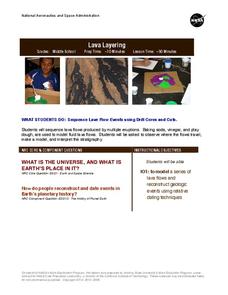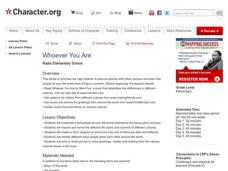Teach Engineering
Earthquakes Living Lab: Finding Epicenters and Measuring Magnitudes
Pairs use an online simulation to determine the epicenter and magnitude of an earthquake. Using real data about the earthquake's maximum S wave amplitudes, they then determine the magnitude. The resource provides a great career...
Noyce Foundation
Which is Bigger?
To take the longest path, go around—or was that go over? Class members measure scale drawings of a cylindrical vase to find the height and diameter. They calculate the actual height and circumference and determine which is larger.
DirectTV
Staying Safe on The Internet
Watson the Walrus takes scholars through an interactive workbook all about internet safety. Safety tips, a maze, crossword puzzle, quiz, and coloring page make up six pages that encourage smart choices while surfing the web.
NASA
Lava Layering
Take the old baking soda and vinegar volcano to the next level by using it to study repeated lava flows over time, examine geologic features on Earth and Mars, and speculate about some of the formations on Mars.
Brandenburg Studies
The Timeline Project
This is a great idea for any social studies classroom to incorporate throughout the year as an ongoing project! Line your walls with a continuous strip of butcher paper to design a large timeline that you can add to as you cover...
Partnership for Educating Colorado Students
Mayan Mathematics and Architecture
Take young scholars on a trip through history with this unit on the mathematics and architecture of the Mayan civilization. Starting with a introduction to their base twenty number system and the symbols they used, this eight-lesson unit...
ReadWriteThink
Critical Media Literacy: Commercial Advertising
Commercial advertising—we can't get away from it, but do we realize just how often we are being advertised to? With this lesson, scholars analyze mass media to identify how its techniques influence our daily lives. Learners browse...
Media Smarts
Teaching TV: Television Techniques
As part of a five-activity unit on how television uses technology and film techniques to communicate meaning, elementary students create their own media productions that demonstrate their understanding of these concepts.
Curated OER
Intermediate Soccer Assessment Plan
Students, using a computer, demonstrate their knowledge of soccer terms.
Curated OER
Sizing Up Schools
Students explore the meaning of education and research the various strategies different American states are using to try to meet the academic requirements of the public school system.
Curated OER
About The Author Lesson 4
Fourth graders engage in a lesson that continues the creation of a specialized Microsoft Word document. They practice creating art using Wordart and inserting images into the document with a paragraph attached. One of the main skills is...
BBC
Community Action
How does community involvement make good citizens? Use all or a few of the included ideas to foster a better understanding of what it means to be a good citizen. Learners will brainstorm community issues, discuss how to get involved, and...
Curated OER
From Ada to Grace to Sandy - Women Have IT
Explore the significant contributions women have made in the field of information technology with an instructive lesson plan. Through class discussion and research, young scholars discover how women have aided in the growth of the field...
BBC
Crime
Crime and punishment! Learners discuss the law, civics, and crime in the UK. They brainstorm lists of crimes and possible punishments, complete activities on a website, role-play a Juvenile Court scenario, and try to think of ways they...
Curated OER
Land or Sea?
Sixth graders access a database to search for desired information, using "and" or "or" connectors where necessary. They choose a connector and search a prepared database of European countries to locate which countries border certain...
Curated OER
Kwanzaa: Invitations and Menus
It's time to celebrate Kwanzaa in the classroom! After studying the traditions of the holiday, learners design a menu decorated in the colors and symbols associated with Kwanzaa.
Curated OER
Off the Record
Music reflects culture and culture is reflected in popular music. Reading an article on how hip-hop has affected the lives of two young men of different races launches an investigation of the development and influences of various musical...
Curated OER
Reading Fiction - Character
The goal of this lesson is to have learners understand how character is created through a combination of what they say and do, and what others say about them. In pairs, learners construct a short dialogue between a parent and child after...
Curated OER
Personification Lesson Plans and Resources
This resource on personification provides three different approaches aimed at different levels. The first, appropriate for upper elementary, provides examples of personification, followed by an exercise that requires replacing a word in...
Curated OER
Whoever You Are
Students examine cultures, traditions, and feeling throughout cultures. In this cultural lesson, students use literature, maps, and cultural information to examine how people have universal feelings despite their different cultures and...
Curated OER
Hillbilly Feud:Language Arts Game
English language learners or native elementary schoolers will enjoy practicing their parts of speech with this interactive grammar game. Set deep in the backwoods of Tennessee, the class splits in two to join either the Hartfields...
BBC
Coasts
Youngsters study the variety of ways that coastlines can be eroded. They do this by accessing a website, embedded in the plan, and answering questions found on the pages. This activity is meant to be done individually, so everyone in the...
Bright Hub Education
Use Pictures or Artwork to Spark Creative Writing
Art in one form can inspire art in another. Use images to inspire writing in your English class. The lesson described here is not detailed; however, the idea is strong. An engaging way to get class members interested in writing, the...
Curated OER
On the Street Where You Live: Online Mapping
Students access the Internet and use Google Maps to pinpoint their home address and get directions to and from school. they write the directions in paragraph format.























